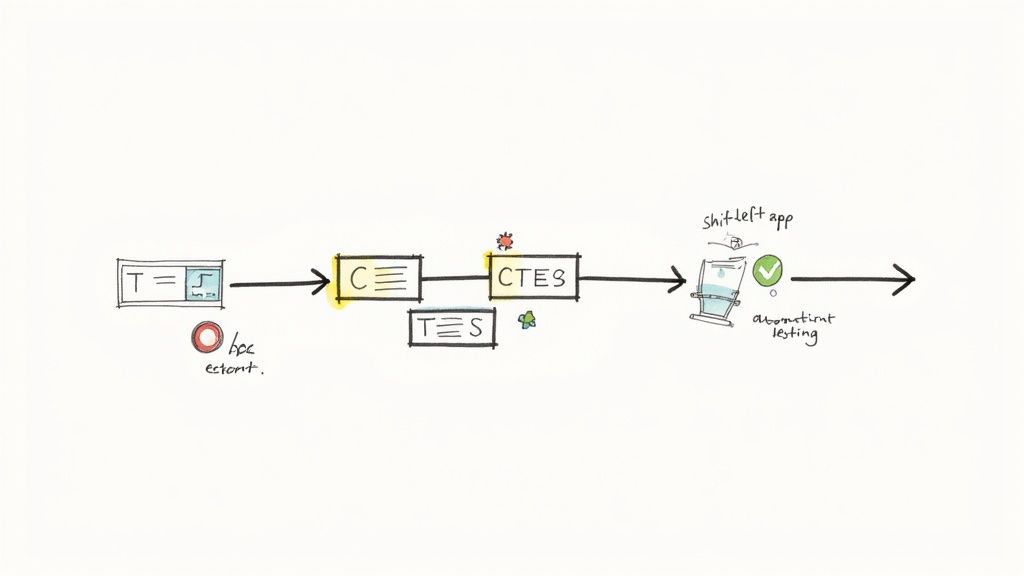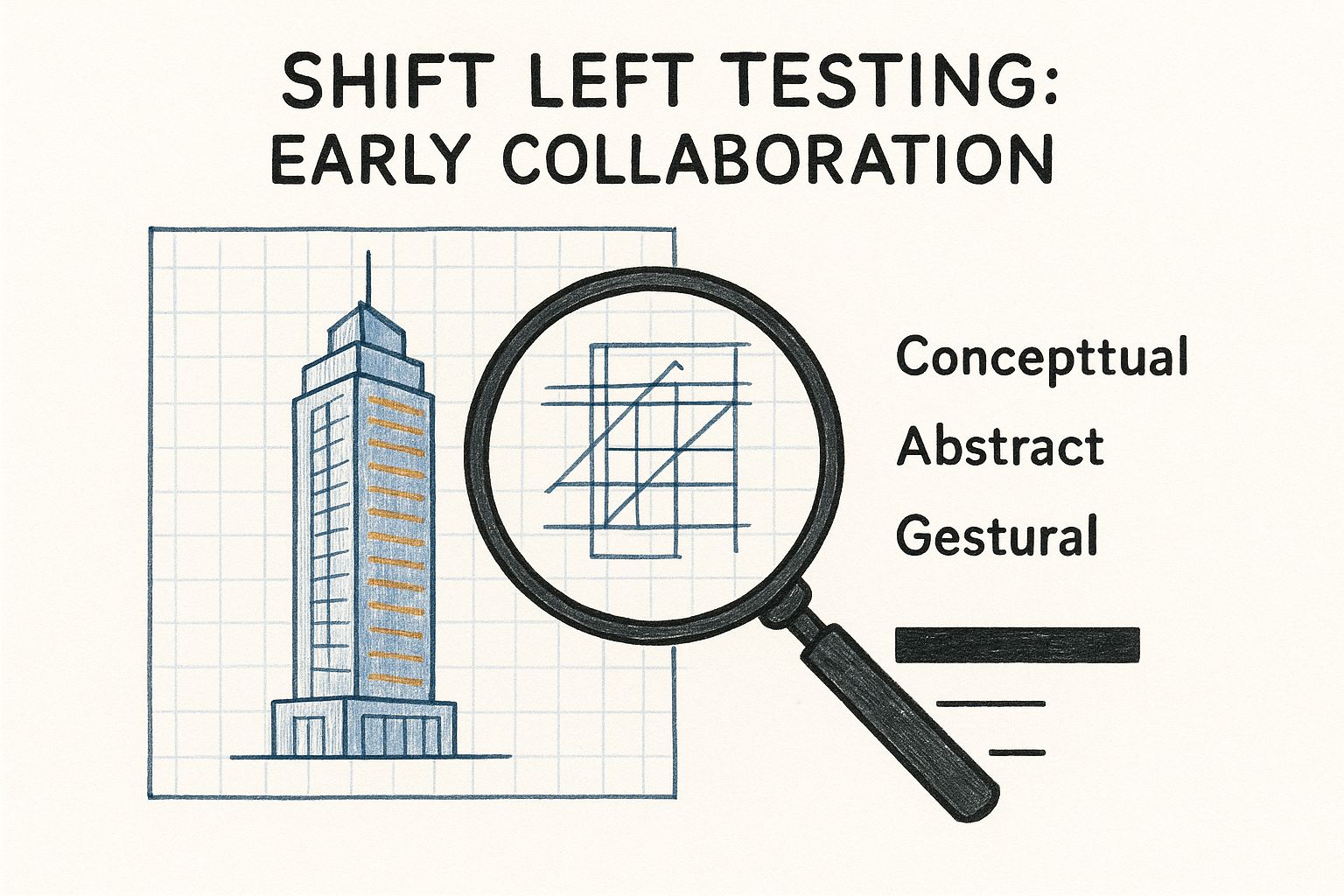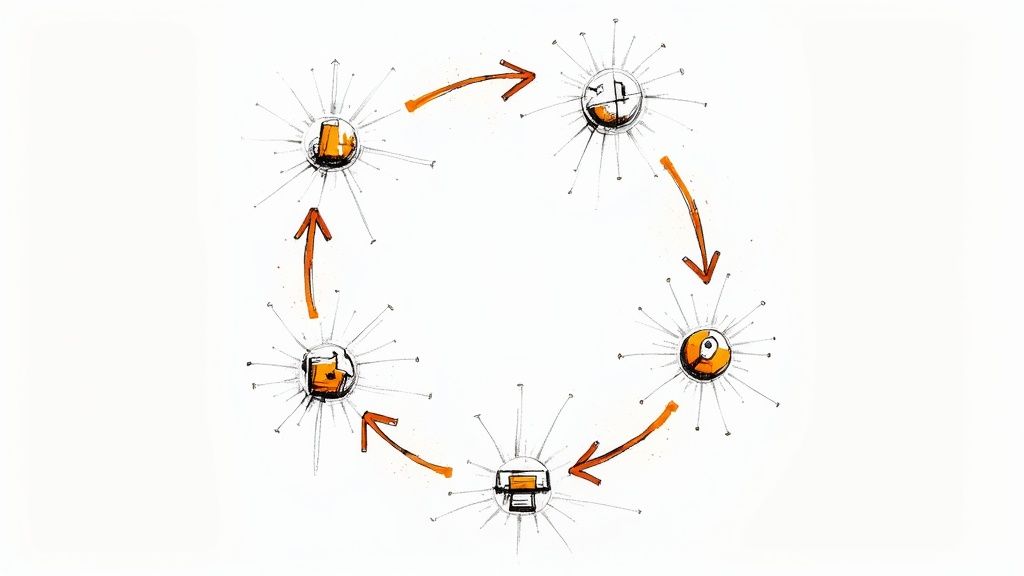What is Shift Left Testing? A Technical Guide to Early Quality & Speed
Learn what is shift left testing and discover practical strategies to integrate testing early in your SDLC for faster, higher-quality software releases.

Shift left testing isn't a buzzword; it's a fundamental change in software development methodology. Instead of treating testing as a final gate before release, this strategy integrates it into the earliest stages of the software development lifecycle (SDLC). The focus shifts from a reactive process of finding defects to a proactive discipline of preventing them, making quality a quantifiable, shared responsibility from day one.
Understanding The Shift Left Testing Philosophy
Consider the process of manufacturing a CPU. It's relatively inexpensive to correct a flaw in the architectural design files (like the GDSII file) before photolithography begins. Discovering that same flaw after etching millions of wafers results in catastrophic financial loss, supply chain disruption, and significant delays.
For years, traditional software testing operated like that post-production quality check—catching defects when they are most complex, expensive, and disruptive to fix. Shift left testing is the antithesis. It's the equivalent of running exhaustive simulations and formal verification on the chip design continuously, from the moment the first logic gate is defined.

This philosophy transforms testing from an isolated phase into a continuous, automated process integral to every stage of development.
The Origin and Core Idea
The concept was introduced by Larry Smith in 2001, representing a significant departure from traditional models. By shifting testing activities to the "left" on a project timeline visualization, teams could replace rigid, sequential workflows with a highly integrated and agile approach. This methodology is a prerequisite for high-performing DevOps and CI/CD pipelines, where velocity and reliability are paramount.
At its core, shift left testing is about making quality assurance a proactive engineering discipline rather than a reactive validation step. It's a mindset that mandates, "Quality is built and verified continuously, not inspected for at the end."
This is a cultural and technical transformation with specific, observable traits:
- Continuous Testing: Automated test suites are triggered by every code commit, providing immediate feedback directly within the CI pipeline.
- Developer Ownership: Developers are responsible not only for implementing functionality but also for writing the unit and integration tests that prove its correctness and resilience.
- Early QA Involvement: QA engineers transition from manual testers to quality architects, contributing to requirements definition and system design to identify potential ambiguities and edge cases before implementation begins.
- Focus on Prevention: The primary objective is to prevent defects from being merged into the main codebase through a layered defense of static analysis, unit tests, and code reviews.
Shift Left vs Traditional Testing At A Glance
A side-by-side comparison highlights the fundamental differences in process, cost, and outcome between the two paradigms. The legacy "shift right" model is ill-suited for modern, fast-paced development.
| Aspect | Traditional Testing (Shift Right) | Shift Left Testing |
|---|---|---|
| Timing | Testing is a distinct phase at the end of the development cycle. | Testing is a continuous activity, starting with requirements analysis. |
| Cost of Fixing Bugs | Extremely high; defects are found late, requiring context switching and extensive regression. | Extremely low; defects are found within minutes of introduction, often by the original author. |
| Team Collaboration | Siloed; developers and QA operate in separate, often adversarial, phases. | Integrated; developers, QA, and operations share responsibility for quality. |
| Goal | Detect and report as many bugs as possible before release. | Prevent defects from being created and integrated into the main branch. |
| Feedback Loop | Days or weeks. | Minutes. |
The contrast is stark. While traditional testing acts as a safety net, shift left engineering focuses on building a fundamentally safer process from the ground up, reducing reliance on that net.
Why Traditional Testing Models Fall Short
To understand the necessity of "shift left," one must analyze the failures of its predecessor, the Waterfall model. This rigid, sequential methodology mandates the full completion of one phase before the next can begin.
In this paradigm, testing was the final, isolated checkpoint before deployment. Developers would commit code for weeks or months. Upon reaching "code freeze," the entire application was handed over to a separate Quality Assurance (QA) team. Their sole function was to identify defects under immense time pressure before a fixed release date. This structure created inherent technical and interpersonal friction.

This "over-the-wall" handoff was a systemic source of inefficiency and project failure.
The High Cost of Late Bug Discovery
The primary architectural flaw of the Waterfall model is its long feedback loop, which finds defects at the moment of maximum remediation cost. A defect identified in production can cost over 100 times more to fix than if it were found during the design phase. This isn't abstract; it's a direct result of increased complexity, context switching, and the blast radius of the bug.
This late-stage defect discovery created a cascade of negative outcomes:
- Massive Budget Overruns: Fixing a foundational architectural flaw post-implementation requires extensive refactoring, code rollbacks, and re-testing, leading to severe budget overruns.
- Unpredictable Release Delays: A single critical bug could halt a release, forcing a high-pressure "war room" scenario and causing the business to miss market windows.
- Team Friction: The pre-release phase often devolved into a blame game between development and QA, eroding trust and collaboration.
When testing is the final gate, it becomes the primary bottleneck. A critical defect doesn't just delay a release; it forces a disruptive, high-risk rework of code developers haven't touched in months, introducing the potential for new, secondary bugs.
An Obsolete Model for Modern Development
The adoption of Agile and DevOps methodologies made the slow, sequential nature of Waterfall untenable. The market demand for rapid iteration, continuous delivery, and responsiveness to user feedback rendered the old model obsolete.
Agile methodologies break large projects into small, iterative sprints. This requires a testing model that operates continuously within each sprint, not as a monolithic phase at the end. This fundamental shift created the need for a new strategy where quality is an embedded, shared attribute of the development process itself. The systemic failures of late-cycle testing directly precipitated the rise of the shift left paradigm.
The Core Principles And Benefits Of Shifting Left
Adopting a shift left model is a cultural and technical transformation. It's about embedding specific, actionable engineering principles into the software development lifecycle, thereby transforming quality from a post-facto inspection into an intrinsic property of the code itself.

The central tenet is that quality is an engineering responsibility. Developers are the first line of defense, responsible for verifying their own code. QA engineers evolve into quality architects and automation specialists, while operations provides feedback on production behavior. This culture of shared ownership relies on effective project collaboration strategies and robust automation.
Foundational Principles in Practice
To transition from theory to execution, teams must adopt several key engineering practices. Each one integrates testing deeply into the development workflow, making it a natural part of the coding process.
- Continuous Testing: Every
git pushtriggers an automated build and test suite in the CI/CD pipeline. Developers receive pass/fail feedback on their changes within minutes. - Developers Own Test Quality: It's no longer sufficient to write feature code. Developers are responsible for writing comprehensive unit and integration tests that prove correctness and handle edge cases. Tools like SonarLint integrated into the IDE provide real-time feedback on code quality and potential bugs as code is written.
- QA Contributes Early and Often: QA engineers participate in requirements gathering and design reviews. They use their expertise to identify ambiguities, uncover missing acceptance criteria, and challenge assumptions in user stories or architectural diagrams before implementation begins.
The primary technical goal is to minimize the feedback loop. A developer must know if their change broke a unit test or an integration point in minutes, not days. This immediate feedback enables on-the-spot fixes while the context is still fresh, dramatically improving efficiency.
The Tangible Business Outcomes
When these principles are implemented, the benefits are quantifiable and directly impact the business's bottom line by improving cost, velocity, and product reliability.
Dramatically Reduced Bug-Fixing Costs
The economic argument for shifting left is compelling. A bug that reaches production can cost over 100 times more to remediate than one caught during the initial commit.
When a defect is identified by a failing unit test moments after the code is written, the developer can fix it instantly. This prevents the costly cascade effect of a bug that contaminates other system components, requires extensive debugging, and necessitates emergency hotfixes and full regression cycles.
Accelerated Time-to-Market
In a traditional model, the testing phase is a notorious bottleneck that creates release delays. Shifting left removes this bottleneck through comprehensive test automation.
High test coverage provides the confidence needed for frequent, automated deployments. Teams can release new functionality faster and more predictably, enabling the business to respond quickly to market demands and gain a competitive advantage. To implement this effectively, mastering 10 advanced automated testing strategies is crucial.
How To Implement A Shift Left Testing Strategy
Implementing a shift left strategy is a systematic engineering effort, not just a process change. It begins with a cultural commitment to shared quality ownership and is realized through the integration of specific tools and automated workflows into the development lifecycle.
The journey starts by dismantling the silo between developers and QA. Quality is reframed as a non-negotiable engineering metric, not a post-development activity. This involves embedding QA engineers in sprint planning and design sessions to challenge assumptions and define testable acceptance criteria from the outset. Once this collaborative foundation is established, you can begin implementing the technical controls.
Integrate Static Analysis into the IDE
The earliest possible point to detect a defect is during code composition. Static Application Security Testing (SAST) and code analysis tools achieve this. By integrating these tools as plugins directly into a developer's Integrated Development Environment (IDE), they receive real-time feedback on bugs, vulnerabilities, and code smells as they type.
- Tool Example SonarQube: The SonarLint IDE plugin, connected to a central SonarQube server, provides immediate, in-line feedback. It acts as an automated code reviewer, flagging issues like potential null pointer exceptions, security hotspots, or overly complex methods.
- Actionable Step: Standardize on an IDE (e.g., VS Code, IntelliJ IDEA) and mandate the installation and configuration of SonarLint. Connect it to a shared SonarQube quality profile to enforce consistent coding standards and quality gates across the entire team.
This immediate feedback loop trains developers to write cleaner, more secure code by default, preventing entire classes of defects from ever being committed.
Automate Early in the CI/CD Pipeline
The next step is to enforce quality gates within your what is continuous integration pipeline. Every code commit to a feature branch must trigger a series of automated validation steps. A failure at any step should block the merge to the main branch.
This automation should be layered:
- Unit Tests: These form the base of the test pyramid. Using frameworks like JUnit (Java), Jest (JavaScript), or PyTest, developers write focused tests for individual functions or classes. They execute in seconds and should run on every commit. A high code coverage target (e.g., >80%) should be enforced.
- Integration Tests: After unit tests pass, these tests verify the interactions between components. This could involve testing a service's API endpoint against a containerized database or validating communication between two microservices.
The governing principle is "fail fast, fail early." A broken build due to a failing test should be an immediate, high-priority event. The developer receives instant notification, preventing defective code from polluting the main branch and impacting other team members.
Embrace DevSecOps and Service Virtualization
A mature shift left strategy extends beyond functional testing to include security and dependency management, an approach known as DevSecOps.
This involves integrating security code reviews early by automating SAST scans within the CI pipeline. Tools can scan for common vulnerabilities (e.g., OWASP Top 10) on every build, treating security flaws as build-breaking bugs.
Furthermore, modern microservices architectures create complex dependencies. Waiting for a dependent service to be fully developed creates a bottleneck. Service virtualization tools solve this by allowing teams to create programmable mocks or stubs of external services. This enables independent development and testing of components, even when their dependencies are unavailable or unstable.
The quantifiable impact is significant. Organizations that effectively shift left report a 20-50% increase in deployment frequency and a reduction in production change failure rates by up to 40%.
Essential Tools For Your Shift Left Strategy
Effective implementation requires a well-integrated toolchain that provides continuous feedback at every stage of the SDLC. This is not about a single tool, but a synergistic collection of technologies.
| Testing Type / Stage | Tool Category | Example Tools |
|---|---|---|
| Code Creation | Static Analysis (SAST) | SonarLint, Checkmarx, Veracode |
| Commit / Build | Unit Testing Frameworks | JUnit, Jest, PyTest |
| CI Pipeline | Build & Automation Servers | Jenkins, GitLab CI, GitHub Actions |
| Integration | Service Virtualization | WireMock, Mountebank, Postman |
| Pre-Deployment | Performance Testing | JMeter, Gatling, k6 |
| Security | Dynamic Analysis (DAST) | OWASP ZAP, Burp Suite |
This table provides a blueprint. The specific tools selected should align with your technology stack, but the functional categories are essential for a comprehensive shift left implementation.
Overcoming Common Implementation Hurdles
Transitioning to a shift left model is a significant engineering initiative that often encounters both cultural inertia and technical challenges. Overcoming these hurdles is critical for a successful implementation.
A primary obstacle is cultural resistance. Developers accustomed to a model where their responsibility ends at "code complete" may view writing comprehensive tests as a secondary task that impedes feature velocity. The "I code, you test" mentality is deeply ingrained in many organizations.
Overcoming this requires strong technical leadership that reframes testing not as a separate activity, but as an integral part of writing production-ready code. This must be supported by dedicated training on testing frameworks and a clear demonstration of the benefits to developers: reduced time spent on debugging and fixing bugs found late in the cycle.
Tackling Technical Debt and Tooling Costs
Another major challenge is the initial investment required to address existing technical debt. For a legacy codebase with low or non-existent test coverage, building a comprehensive automated test suite represents a substantial upfront effort.
Management may perceive this as a cost center with delayed ROI. The key is to frame this as a strategic investment in future development velocity and system stability.
To secure buy-in, present a data-driven case. The cost of building a robust test suite now is a fraction of the cumulative cost of fixing production incidents, customer churn, and developer time lost to bug hunts later. Use metrics like Change Failure Rate and Mean Time to Recovery (MTTR) to demonstrate the value.
Additionally, integrating and configuring the necessary toolchain (CI/CD servers, static analysis tools, etc.) requires dedicated engineering effort and a phased implementation plan.
Debunking the Myth of the Disappearing QA Team
A common misconception is that shift left makes the QA team redundant. The opposite is true. The role of QA professionals evolves to become more technical, strategic, and impactful.
Instead of performing repetitive manual regression tests, QA engineers transition into more senior roles:
- Quality Strategists: They design the overall testing strategy, define quality gates, and determine the optimal mix of unit, integration, and end-to-end tests.
- Automation Experts: They build, maintain, and scale the test automation frameworks that developers use. They are the stewards of the testing infrastructure.
- Quality Coaches: They act as subject matter experts, mentoring developers on best practices for writing effective, maintainable tests and promoting a quality-first engineering culture.
This evolution is a core component of modern software quality assurance processes. It elevates the QA function from a late-cycle gatekeeper to a critical enabler of speed and reliability throughout the entire SDLC.
Got Questions? We've Got Answers
Even with a clear strategy, specific technical and procedural questions arise during implementation. Here are answers to some of the most common ones.
Can Shift Left Work In Heavily Regulated Industries?
Yes, and it is arguably more critical in these environments. In sectors like finance (SOX) or healthcare (HIPAA), shift left provides a mechanism for continuous compliance.
Instead of a high-stakes, manual audit at the end of a release cycle, compliance and security controls are codified and automated within the CI/CD pipeline. For example, a pipeline can include automated scans for known vulnerabilities (CVEs) in third-party libraries or static analysis rules that enforce secure coding standards. This creates an auditable trail of continuous validation, transforming compliance from a periodic event into an ongoing, automated process.
Does Shift Left Replace End-to-End Testing?
No, it redefines its purpose. End-to-end (E2E) testing remains essential for validating complete user workflows across multiple integrated services in a production-like environment.
Shift left drastically reduces the number of defects that reach the E2E stage. By catching bugs early at the unit and integration levels, the E2E suite's primary purpose shifts from defect discovery to workflow validation. This makes E2E tests less flaky, faster to run, and more reliable as a final verification of system health rather than a primary bug-hunting tool.
Is This Only For Agile And DevOps Teams?
While shift left is a natural fit for the iterative cycles of Agile and DevOps, its core principles can provide value even in more traditional models like Waterfall.
Even in a sequential process, introducing static code analysis tools in the developer's IDE or mandating peer code reviews during the development phase will catch a significant number of defects earlier. However, the full benefits of rapid feedback loops and continuous testing are only realized in an environment with a mature CI/CD pipeline, which is a hallmark of Agile and DevOps practices.
Ready to implement a robust DevOps strategy without the hiring overhead? OpsMoon connects you with the top 0.7% of remote DevOps engineers to build, automate, and scale your infrastructure. Start with a free work planning session and get paired with the exact expertise you need to accelerate your releases and improve system reliability.
